Practice Questions: Seating Arrangement- 3 | Logical Reasoning for CLAT PDF Download
Directions for Questions 1 to 5: Read the following information carefully and answer the questions given below:
(i) P, Q, R, S, T, U and V are sitting around a circular table facing the centre
(ii) R is next to the left of U and V is second to the left of R.
(iii) P is sitting third to the left of T.
(iv) Q is between S and T.
Q1: Which of the following is true?
(a) R is fourth to the right of T.
(b) P is to the immediate right of V.
(c) S is second to the left of T.
(d) Q is second to the right of V.
Ans: (b)
We can arrange the persons in the following way.
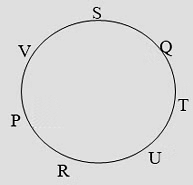
P is to the immediate right of V is correct.
Q2: What is the position of U?
(a) Fourth to the right of S
(b) To the immediate left of R
(c) Between P and T
(d) To the immediate right of P
Ans: (a)
We can arrange the persons in the following way.

U is sitting fourth to the right of S.
Q3: Which of the following is false?
(a) P is fourth to the right of T.
(b) U is to the immediate right of R.
(c) U is third to the right of S.
(d) Q is to the immediate left of S.
Ans: (c)
We can arrange the persons in the following way.
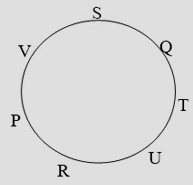
U is third to the right of S is wrong.
Q4: Which of the following pairs has the first person sitting to the immediate left of the second person?
(a) QT
(b) RP
(c) VS
(d) SV
Ans: (d)
We can arrange the persons in the following way.

S is sitting to the left of V.
Q5: In which of the following options, the middle person is sitting between the other two?
(a) URT
(b) TUQ
(c) STQ
(d) None of these
Ans: (d)
We can arrange the persons in the following way.
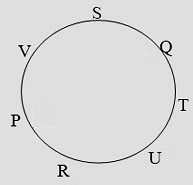
None of the options is true.
Directions for Questions 6 to 10: Read the following information carefully and answer these questions:
(i) K, L, M, N, O, P and Q are sitting in a circle facing at the centre and playing cards.
(ii) O is neighbour of K and N.
(iii) Q is not between P and M.
(iv) P is to the immediate right of K.
(v) L is second to the left of Q.
Q6: Which of the following pairs has the second person sitting immediately to the right of the first?
(a) KL
(b) ML
(c) OK
(d) None of these
Ans: (c)
We can arrange the persons in the following way.
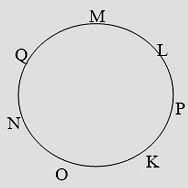
K is sitting immediately right of O.
Q7: Who are the neighbours of L?
(a) K and P
(b) M and N
(c) P and M
(d) None of these
Ans: (c)
We can arrange the persons in the following way.

P and M are the neighbours of L.
Q8: Which of the following does not have the pair of persons sitting adjacent to each other?
(a) LK
(b) ML
(c) NO
(d) QN
Ans: (a)
We can arrange the persons in the following way.
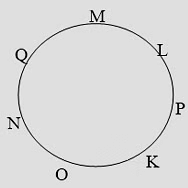
L and K are not sitting next to each other.
Q9: Which of the following persons are sitting adjacent to each other in clockwise order as shown?
(a) LQM
(b) PLM
(c) MNQ
(d) ONQ
Ans: (d)
We can arrange the persons in the following way.
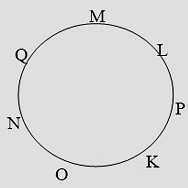
ONQ are sitting adjacent to each other in clockwise direction.
Q10: What is the position of P?
(a) Second to the left of M
(b) Second to the right of M
(c) To the immediate left of K
(d) To the immediate right of L
Ans: (a)
We can arrange the persons in the following way.

P is second to the left of M.
|
38 videos|128 docs|75 tests
|
FAQs on Practice Questions: Seating Arrangement- 3 - Logical Reasoning for CLAT
| 1. What is a seating arrangement in the context of the CLAT exam? |  |
| 2. How can I improve my skills in solving seating arrangement questions for the CLAT exam? |  |
| 3. Are seating arrangement questions common in the CLAT exam? |  |
| 4. Can I expect complex seating arrangement questions in the CLAT exam? |  |
| 5. Are there any specific strategies for solving circular seating arrangement questions in the CLAT exam? |  |
















